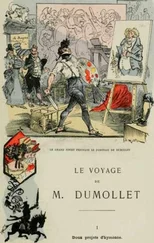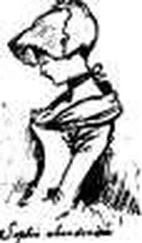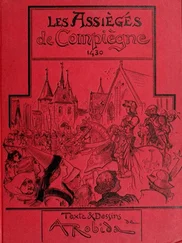Albert Robida - Yester-year; ten centuries of toilette from the French of A. Robida
Здесь есть возможность читать онлайн «Albert Robida - Yester-year; ten centuries of toilette from the French of A. Robida» весь текст электронной книги совершенно бесплатно (целиком полную версию без сокращений). В некоторых случаях можно слушать аудио, скачать через торрент в формате fb2 и присутствует краткое содержание. Жанр: Старинная литература, на английском языке. Описание произведения, (предисловие) а так же отзывы посетителей доступны на портале библиотеки ЛибКат.
- Название:Yester-year; ten centuries of toilette from the French of A. Robida
- Автор:
- Жанр:
- Год:неизвестен
- ISBN:нет данных
- Рейтинг книги:4 / 5. Голосов: 1
-
Избранное:Добавить в избранное
- Отзывы:
-
Ваша оценка:
- 80
- 1
- 2
- 3
- 4
- 5
Yester-year; ten centuries of toilette from the French of A. Robida: краткое содержание, описание и аннотация
Предлагаем к чтению аннотацию, описание, краткое содержание или предисловие (зависит от того, что написал сам автор книги «Yester-year; ten centuries of toilette from the French of A. Robida»). Если вы не нашли необходимую информацию о книге — напишите в комментариях, мы постараемся отыскать её.
Yester-year; ten centuries of toilette from the French of A. Robida — читать онлайн бесплатно полную книгу (весь текст) целиком
Ниже представлен текст книги, разбитый по страницам. Система сохранения места последней прочитанной страницы, позволяет с удобством читать онлайн бесплатно книгу «Yester-year; ten centuries of toilette from the French of A. Robida», без необходимости каждый раз заново искать на чём Вы остановились. Поставьте закладку, и сможете в любой момент перейти на страницу, на которой закончили чтение.
Интервал:
Закладка:
The corset was no longer the simple ' basquine ' ; that was inoffensive enough at first. The ' corps piqué,' which was endured by the fair ladies of this later period, was an instrument of torture, a hard and solid mould into which the wearer had to be compressed, there to remain and suffer, in spite of the splinters of wood that " penetrated the flesh, took the skin off the waist, and made the ribs ride up one over the other." Montaigne and Ambroise Paré are witnesses on behalf of this indictment of the ' corps pi([ué,' and the latter, at least, must have known somethinfr about it.
Like the farthingale, 'only more so/ the corset will witness the burial of successive ages, will survive all other fashions, notwithstandiusr every attack upon it, and the doctors who are unanimous in their excommunication of it, and
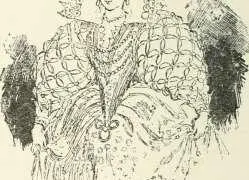
Under Henry III.
will be ever-victorious over all and sundry, victorious against the clearest evidence. The absurd ' mignons ' of Henry the Third actually succeeded in making men adopt it for a while !
The celebrated beauties of the time, Queeu Margot, and her husband's mistress Madame de Sauves, look like idols braced up in damascened cuirasses, in their state costumes, with their stiff, glitterinQ- bodices, and their

Margot.
gorgeous array of gold and precious stones. " Touch me not !" say those formidable pointed ruÉfs, and yet the wearers of them were by no means inaccessible.
All the women of the period, sad and sombre as it was, were bitten by this mauia for luxury. There was not one of the smaller nobility, or a lawyer's wife, or a ' city madam,' who did not try to imitate the great ladies in everything, to the displeasure of their husbands.
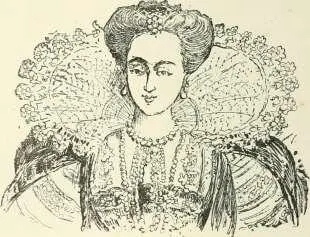
Full dress, Médicis style.
and the peril of fortunes which had already suffered by the evils of the time.
The brilliant sixteenth century, the age of the Renaissance, which gave birth to so many artists and men of letters, to doughty knights, and dazzling dames, came nevertheless to a bad ench Over that termination, about that epoch of Henry the Third with his corrupt refinement, about the Court and the City, about fair and noble women and exquisites and ' mignons,' there hung a scent of blood which it needed all the strong perfumes, the musk and amber then in vogue, to overpower and disguise.
Marguerite de Valois, a flower whose perfume was deadly, was to survive this epoch, and to die in 1615, some years later than Henri Quatre, her former husband. To the last she was an old coquette, painted, bedizened, and musk-scented, and she strove, in despite of her age, and the corpulence that destroyed her goddess-like pretensions, to keep up the solemn and stately graces and the state costumes of her best days. She migrated regularly with her little Court from her château in Languedoc to her Parisian Hôtel de Sens, which still exists, now and again promoting to her good graces some handsome cavalier, or some pretty page—a page like those mentionea in the chronicle of her earlier 3^ears, when she was accused of having their boyish locks shorn to make lisfht-colon red wio^s for her own wear.
Shortly before the death of this princess, now " the grotesque Margot," one of these petted pages was stabbed under her roof by an equerry who aspired to the exclusive possession of the favour of the aged Queen. Marguerite became as infuriated as a wounded lioness, and in order to avenge the object of her very latest love she claimed her feudal right of doing justice in her own house (in Scottish feudal times, this was called the right of " pit and gallows "), condemned the guilty person to death, and had him beheaded forthwith under her own bloodthirsty eyes, in the presence of a mob, on the very threshold of the Hôte] de Sens.
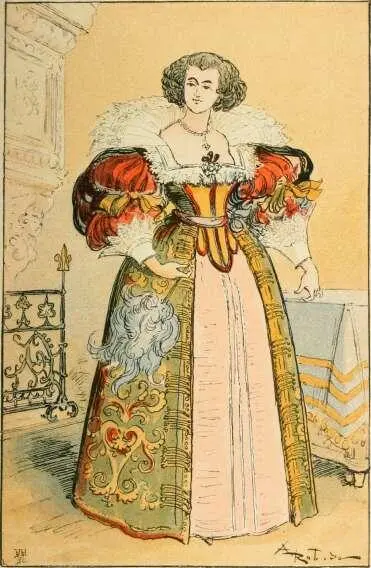
DAMP. LOUIS XIII.
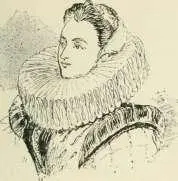
The collerette ruff.
VI.
HENRY THE FOURTH AND LOUIS THE THIRTEENTH.
A return to comparative simplicity—Women-towers— Tall head-dresses—The excommunication of bare necks—Gowns with large flower-patterns—High necks and low necks—Long waists—Richelieu's edicts—The obedient lady—Short waists.
Some eras live long, but others die young ; the sixteenth oentury, which had an exceptionally strong constitution, lasted until the end of the reign of the Béarnais, with its ideas and its manners, its ways and its modes. We shall afterwards see that the seventeenth century lasted in the same way under Louis XIV. to the detriment of the eighteenth, and that the charming but unfortunate eighteenth century came to a melancholy and premature close, dying suddenly in the year '89.
The years of grace of the sixteenth century, under the sceptre of Henri Quatre, were like convalescence after brain-fever ; while they lasted, France, reduced to extremity by her malady, revived, the poison was expelled from her veins, all was repaired, cleansed, and sanitated.
After the absurd and unwholesome devices of the reign of Henry the Third, dress assumed an unpretending character, an aspect of good, honest frankness, if we may be permitted to talk of frankness in dress. The costume was, indeed, but little altered, but the lines were simplified, and all that was superfluous in the details was suppressed.
No doubt the fashions for both sexes were less elegant, and there was a good deal that was absurd in them even yet, but this absurdity was harmless. Excessive pretension, with dissolute grace and refinement, had been discarded ; but fashion, in seeking simplicity, had strayed into heaviness and awkwardness, only, however, to emerge from both into the bold and dashing elegance of the costume of the period of Louis XIII. Yet we must not take this simplicity too literally, for it was only comparative.
On occasions of state the ladies displayed just as much jewellery as before. The queen by whom the divorced Marguerite was succeeded (a second Medicis Marriage which was not much of a success for the Béarnais, who had already only too much reason to remember Catherine), Marie de Medicis, the " queen of the right hand," as the saying was, and Gabrielle d'Estrées, Duchesse de Verneuil, queen " on the side of the heart," with all the other fine ladies, appeared " at fetes, ballets, masquerades, and collations, richly adorned and magnificently attired, and so laden with precious stones that they could not move about."
On one great occasion the queen wore a gown sown with 32,000 pearls and 3,000 diamonds, and her example was followed by lesser personages, who cheerfully expended more than their revenues in dress and its accessories, in garments of brocade, satin, and exquisite damask, flowered and bordered with gold, and laden with various kinds of jewellery. This was an odd sort of simplicity, and yet, when we examine the pictures and prints of the time, we clearly perceive that a great difference existed between the ultra-refinements of fashion in the time of Henry III. and its somewhat clumsy finery in the time of Henri IV.
Head-dresses were higher, and a great quantity of false hair, of the colours in vogue, was worn.
Читать дальшеИнтервал:
Закладка:
Похожие книги на «Yester-year; ten centuries of toilette from the French of A. Robida»
Представляем Вашему вниманию похожие книги на «Yester-year; ten centuries of toilette from the French of A. Robida» списком для выбора. Мы отобрали схожую по названию и смыслу литературу в надежде предоставить читателям больше вариантов отыскать новые, интересные, ещё непрочитанные произведения.
Обсуждение, отзывы о книге «Yester-year; ten centuries of toilette from the French of A. Robida» и просто собственные мнения читателей. Оставьте ваши комментарии, напишите, что Вы думаете о произведении, его смысле или главных героях. Укажите что конкретно понравилось, а что нет, и почему Вы так считаете.

